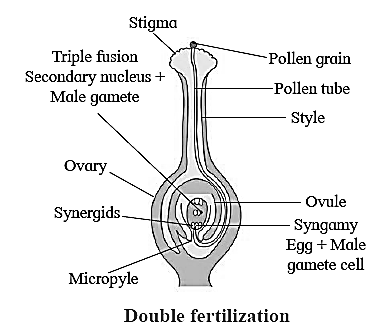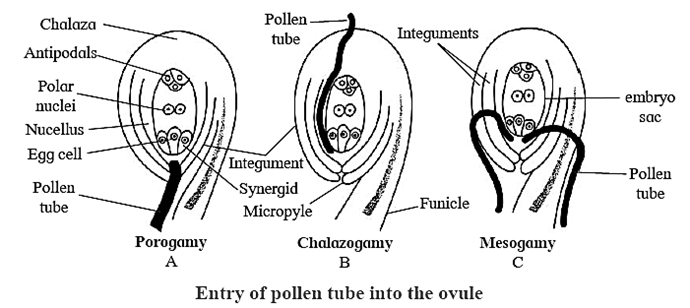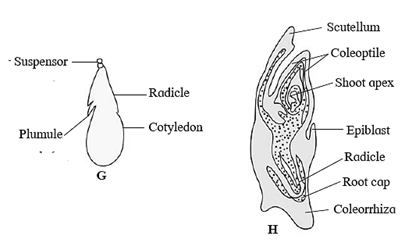Reproduction in Lower & Higher Plants
Class-12th-Biology-Chapter-1-Maharashtra Board
Notes
Topics to be Learn : Part-2
|
.Pollination : The transfer of pollen grains from the anther to the stigma is called pollination.
Types of pollination : Pollination is of two types, viz., self-pollination and cross pollination.
- Pollen grains are non-motile and female gametes are produced at different site. To bring both gametes together, this is a necessary act.
- Agents of pollination also act as agent for seed dispersal.
Self-pollination [Autogamy] :The transfer of pollen grains from the anther to the stigma of the same flower or a different flower possessing the same genetic make-up is called self-pollination.
- Occurs in single flower or two flowers in same plant.
- Autogamy : Bisexual flower pollinated by its own pollen shows autogamy.
- Offspring produced by self-pollination is genetically identical to parents. e.g. Pea
Cross Pollination — Outbreeding
Cross pollination (Allogamy) : The transfer of pollen grains from the anther of a flower to the stigma of another flower borne by a different plant possessing dissimilar genetic make-up is called cross pollination.
- Xenogamy : Two different plants are involved.
- Need pollinating agent.
- Genetically varied offspring e.g. food and fibre crops
Types of cross pollination : (a) Chasmogamy : When flowers open and expose their sex organs. (b) Homogamy : Condition when anther and stigma mature at same time. (c) Cleistogamy : Condition when flowers remain closed, e.g. Viola, Commelina. (d) Geitonogamy : Conditon where transfer of pollen grains to stigma of other flower produced on same plant, e.g. Unisexual flowers of Cucurbita.
Agents of pollination : (1) Abiotic (Non-living) Anemophily : The transfer of pollen grains through wind is called anemophily. Hydrophily : The transfer of pollen grains with the help of water is called hydrophily. (2) Biotic (Living) : Entomophily : Pollination with the help of insects is called entomophily. The insect pollinated flowers are called entomophilous flowers. Entomophilous flowers show the following adaptations : Entomophily is seen in plants like rose, Jasmine, Cestrum, Salvia, etc- I Ornithophily : The transfer of pollen grains through birds is called ornithophily. Chiropterophily : The pollination that occurs with the help of bats is called chiropterophily.
Outbreeding devices — Contrivances :
- Mechanism to prevent self-pollination and promote cross pollination.
- Self-pollination results inbreeding depression, hence cross pollination needed.
- Devices observed in plants.
Devices observed in plants : Unisexuality, dichogamy, prepotency, heteromorphy and herkogamy are the outbreeding devices. (1) Unisexuality : (2) Dichogamy : When stamens and carpels mature at different times in a bisexual flower, the condition is known as dichogamy. (3) Prepotency (4) Heteromorphy : (5) Herkogarny : (6) Self-sterility: Self-incompatibility or self-sterility is a genetic mechanism that prevents germination of pollen on stigma of same flower.
Pollen-Pistil Interaction :
Self-incompatibility or self-sterility is a genetic mechanism that prevents germination of pollen on stigma of same flower. This favours cross pollination. E.g. Tobacco.
- In pollen-pistil interaction, when pollen grain is deposited on stigma, pistil has the ability to recognize and allow germination of right type of pollen.
- Special type of proteins on stigmatic surface determine compatibility or incompatibility.
- A physiological mechanism operates to ensure successful germination of compatible pollen.
- Compatible pollen absorbs water and nutrients from stigmatic surface that are absent in pollen and then pollen tube emerges which grows through style.
- Pollen tube emerges from germ pore and passes through style to ovule.
- Tip of pollen tube enters synergid.
- A Growth of pollen tube is determined by specific chemicals.
- Pollen grains can be induced to grow on artificial medium having sucrose and boric acid — in vitro tube growth.
Artificial hybridization : It is one of the major approaches used in the crop improvement and plant breeding programmes.
Double fertilization : The process of fertilization where both the male gametes participate in the complex fertilization mechanism seen in angiosperms is called double fertilization.

Importance of the double fertilization :
Characteristic feature of angiosperms Porogamy : Pollen tube entering the ovule through micropyle. (Most common type - enters synergid and releases its content — 2 non-motile male gametes) Chalazogamy : Entry of pollen tube through chalaza. Mesogamy : Entry of pollen tube through integuments. Siphonogamy : Non-motile gametes present in pollen tube.

Process of double fertilization :
Out of the two male gametes produced by the male gametophyte in angiosperms, one unites with the female gamete and the other with the secondary nucleus. Since both the male gametes take part in fertilization and fertilization occurs twice, it is called double fertilization.
- During double fertilization, the pollen tube on reaching the ovule enters the embryo sac through micropyle and bursts in one of the synergids. Owing to this, the two male gametes contained in the pollen tube, are set free.
- Out of the two male gametes, one unites with the egg or female gamete and the other unites with the secondary nucleus of the embryo sac, forming a triploid or triple fusion nucleus, called the primary endosperm nucleus. The process involving the fusion of one of the male gametes with the egg nucleus, resulting in the formation of a diploid zygote is called syngamy.
- The reproductive process in which non-motile male nuclei are carried to the egg cell through a pollen tube is called siphonogamy.
- After fertilization, zygote develops into an embryo. Certain changes take place in the ovule leading to the development of a seed.
Process of double fertilization in embryo sac (1) Syngamy (Generative fertilization) 1 male gamete unites with egg cell -> (n) + (n) = 2n -> Zygote (2n) -> Embryo (Generative fertilization) (2) Triple fusion (Vegetative fertilization) : Triple fusion is also called second fertilization. Out of the two male gametes in angiosperms, the first one fuses with the egg to form the zygote, while the second one fuses with the secondary nucleus to form primary endosperm nucleus. This is called triple fusion. Since each of the polar nuclei is a sister nucleus of the egg, it is called second fertilization. First fusion involves the fusion of a male gamete with the egg; the second fusion involves the fusion of two polar nuclei to form the secondary nucleus and the third fusion involves the fusion of the other male gamete with the secondary nucleus.
Significance of double fertilization :
Development of Endosperm :
- Endosperm is a nutritive tissue. It nourishes the developing embryo.
- The endosperm develops from the primary endosperm nucleus (PEN).
- The endosperm is a post fertilization tissue.
- There are two types of seeds depending upon the presence or absence of endosperm, endospermic and non-endospermic.
- Castor, coconut, maize, etc. are endospermic seeds, while bean, pea, gram, etc. are non-endospermic seeds.
Types of endosperm : There are three types of endosperm, viz., nuclear, cellular and helobial. Nuclear endosperm : Cellular endosperm : Helobial endosperm :

Mosaic Endosperm : Endosperm containing tissues of two different types is called mosaic endosperm.
- In plants like corn the endosperm contains patches of two different colours. It forms a sort of mosaic pattern.
Development of Embryo :
Embryogenesis : The process of development of zygote into embryo is called Embryogenesis.
Zygotic embryo is situated towards micropylar end in embryo sac.
When some amount of endosperm is formed then only growth of embryo starts.
Zygote develops wall around it and becomes oospore.
Oospore divided into 2 celled pro-embryo : The oospore undergoes a transverse division to form a large basal cell towards the micropyle and a small apical or terminal cell towards the chalaza of the embryo sac. This two celled structure is called proembryo.

Embryogenesis is similar till octant stage in dicot and monocot embryo development.
In Monocot embryo - Single cotyledon
- Scutellum — shield shaped cotyledon
- Coleorhiza — Protective covering of radicle
- Coleoptile — Protective covering of plumule

Seed and fruit development : The goal of reproduction, in every living organisms including plants, is to create offsprings for the next generation. One of the ways that plants can produce offpsrings is by forming (making) seeds.
Fertilization initiates seed formation.
Integuments form seed coat.
- Testa : Outer integument.
- Tegmen : Inner integument.
Perisperm : Remnants of nucellus in seed. e.g. black pepper, beet
Pericarp : Ovary wall becomes fruit wall
Seeds :
- Endosp'ermic or albuminous— e.g. Castor, Maize
- Non-Enddspermic or exalbuminous-e.g. Bean, Pea

Cotyledons : Store food materials.
Micropyle in seed coat : For emergence of radicle.
Significance of Seed and Fruit Formation:
Seed dormancy : It is a state of metabolic arrest which helps in survival of organism in unfavourable environmental conditions.
Apomixis: When embryo(s) are formed through asexual method of reproduction without gamete formation, genetically identical plants can be produced rapidly and effectively by apomixis.
i.e. it is a phenomenon of formation of embryo through asexual methods.
Apogamy : Gametophytic cell produces embryo without fertilization.
Apospory : Sporophytie cell produces embryo without fertilization.
Agamospermy : Seed is produced but embryo inside is formed without meiosis and syngarny.
There are three main categories of apomixis : (a) Recurrent (b) Non-recurrent (c) Adventive embryony. Recurrent apomixis : In this diploid sporophytic cell, archesporial cell or nucellus form embryos, When diploid megaspore mother cell forms embryo sac it is known as diplospory. It is also called apospory. Non-recurrent apomixis : Haploid embryo sac is formed but the embryos arise either from egg cell or any other haploid cell. It ii also known as apogamy. Adventive Embryony : In this in addition to normal zygotic embryo, additional embryos develop from nucellus or integuments. It results in polyembryony.
Parthenocarpy : It is a condition in which fruit is developed without event of fertilization.
- It is a natural process observed on Pineapple and Banana.
- A chemical stimulus in the form of auxin (IAA) is given by placental tissues of unfertilized ovary.
- Due to the stimulus, enlargement of ovary takes place to form a fruit.
- Parthenocarpic fruits are without seeds. E.g. Banana, Pineapple, Papaya
- Can be induced artificially by spraying hormones gibberellins or other physical methods. E.g. Grapes.
Polyembryony : It is a condition when more than one embryos are developed inside the seed.
- It was first noticed in Citrus by Leeuwenhock.
- When embryos develop from diploid cells of nucellus or integuments, it is described as adventive polyembryony.
- When zygote divides into small units which develop into embryos then it is called cleavage polyembryony.
- It results in multiple seedlings and is of significance in horticulture.
Advantages :
To be note :
|
Click on below link to get PDF from store
MSBSHSE-Class 12th-Biology-Chapter-1-Reproduction in Lower & Higher Plants-Book
MSBSHSE-Class 12th-Biology-Chapter-1-Reproduction in Lower & Higher Plants-Notes
MSBSHSE-Class 12th-Biology-Chapter-1-Reproduction in Lower & Higher Plants-Solution
PDF SET :
All Chapters Notes-Class-12-Biology-(15-PDF)-Maharashtra Board-Rs-130
All Chapters Solutions-Class-12-Biology-(15-PDF)-Maharashtra Board-Rs-128
All Chapters Notes+Solutions-Class-12-Biology-(30-PDF)-Maharashtra Board-Rs-240
[/su_box]
Useful links :
| Main Page : - Maharashtra Board Class 12th-Biology - All chapters notes, solutions, videos, test, pdf.
PDF Store : MSBSHSE -Class 12th- Biology – All Chapter wise -PDF Next Chapter :Chapter-2-Reproduction in Lower & Higher Animals - Online Notes |